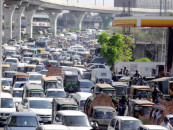Banksy mural at London court erased but gains attention through 'Streisand effect'
Despite the swift erasure, the act has magnified public interest and solidified its status as political artwork.

A new Banksy mural painted on the Royal Courts of Justice in London was erased on Wednesday, but though social media users argue that the removal has only amplified its presence.
The stencilled image depicted a judge in traditional wig and gown striking a protester with a gavel while the protester held a blood-stained placard.
Court administrators ordered the work to be removed, citing the 143-year-old courthouse’s protected status as a Victorian gothic revival landmark. A spokesperson said the building must retain its original character. The Metropolitan Police confirmed they are investigating the piece as possible criminal damage.
Banksy revealed the mural by posting a photo on Instagram, his typical method of authentication. Within hours, workers began removing the artwork from the courthouse wall.
Despite the swift erasure, the act has created what observers describe as a Streisand effect: the attempt to hide or suppress the mural has in fact magnified public interest and solidified its status as an iconic political artwork.
When you try to remove a piece of art and accidentally make it better. pic.twitter.com/PpLGuZkpyI
— Barry Malone (@malonebarry) September 10, 2025
The anonymous artist, known for his critiques of government policy, migration, and war, did not comment on the removal.
Activists have interpreted the mural as a subtle response to the UK government’s ban on the group Palestine Action, which was recently proscribed as a terrorist organisation. Nearly 900 people were arrested at a London protest challenging the ban, with the Royal Courts of Justice itself involved in rulings on the matter.




















COMMENTS
Comments are moderated and generally will be posted if they are on-topic and not abusive.
For more information, please see our Comments FAQ